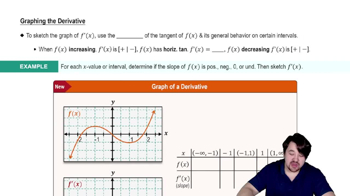Use the graph of in the figure to find the following values or state that they do not exist. <IMAGE>
Table of contents
- 0. Functions7h 54m
- Introduction to Functions16m
- Piecewise Functions10m
- Properties of Functions9m
- Common Functions1h 8m
- Transformations5m
- Combining Functions27m
- Exponent rules32m
- Exponential Functions28m
- Logarithmic Functions24m
- Properties of Logarithms36m
- Exponential & Logarithmic Equations35m
- Introduction to Trigonometric Functions38m
- Graphs of Trigonometric Functions44m
- Trigonometric Identities47m
- Inverse Trigonometric Functions48m
- 1. Limits and Continuity2h 2m
- 2. Intro to Derivatives1h 33m
- 3. Techniques of Differentiation3h 18m
- 4. Applications of Derivatives2h 38m
- 5. Graphical Applications of Derivatives6h 2m
- 6. Derivatives of Inverse, Exponential, & Logarithmic Functions2h 37m
- 7. Antiderivatives & Indefinite Integrals1h 26m
- 8. Definite Integrals4h 44m
- 9. Graphical Applications of Integrals2h 27m
- 10. Physics Applications of Integrals 3h 16m
- 11. Integrals of Inverse, Exponential, & Logarithmic Functions2h 31m
- 12. Techniques of Integration7h 41m
- 13. Intro to Differential Equations2h 55m
- 14. Sequences & Series5h 36m
- 15. Power Series2h 19m
- 16. Parametric Equations & Polar Coordinates7h 58m
1. Limits and Continuity
Introduction to Limits
Problem 2.4b
Textbook Question
Use the graph of g in the figure to find the following values or state that they do not exist. <IMAGE>
x→0limg(x)
 Verified step by step guidance
Verified step by step guidance1
Identify the behavior of the function g(x) as x approaches 0 from both the left and the right sides on the graph.
Observe the y-values that g(x) approaches as x gets closer to 0 from the left (x -> 0^-).
Observe the y-values that g(x) approaches as x gets closer to 0 from the right (x -> 0^+).
Determine if the left-hand limit and the right-hand limit are equal. If they are, the limit exists and is equal to this common value.
If the left-hand limit and the right-hand limit are not equal, state that the limit does not exist.
 Verified video answer for a similar problem:
Verified video answer for a similar problem:This video solution was recommended by our tutors as helpful for the problem above
Video duration:
2mPlay a video:
Was this helpful?
Key Concepts
Here are the essential concepts you must grasp in order to answer the question correctly.
Limits
A limit is a fundamental concept in calculus that describes the behavior of a function as its input approaches a certain value. It helps in understanding the function's value at points where it may not be explicitly defined. For example, the limit of g(x) as x approaches 0 indicates what value g(x) approaches as x gets closer to 0, which is crucial for analyzing continuity and differentiability.
Recommended video:

One-Sided Limits
Continuity
Continuity of a function at a point means that the function is defined at that point, the limit exists, and the limit equals the function's value at that point. If g(x) is continuous at x = 0, then the limit as x approaches 0 will equal g(0). Understanding continuity is essential for determining the behavior of functions and their limits.
Recommended video:

Intro to Continuity
Graph Interpretation
Interpreting the graph of a function is crucial for visualizing its behavior, especially when evaluating limits. The graph provides insights into the function's values, trends, and any discontinuities. By analyzing the graph of g, one can determine the limit as x approaches 0 by observing the y-values that g(x) approaches, which aids in answering the question effectively.
Recommended video:

Graphing The Derivative

 6:47m
6:47mWatch next
Master Finding Limits Numerically and Graphically with a bite sized video explanation from Patrick
Start learningRelated Videos
Related Practice
Textbook Question
